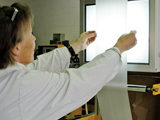Bio-based plastics: Advantages and disadvantages, market, perspectives
We are all using plastics. In 2011, 280 million tons of plastics were produced worldwide. The lion's share was made from crude oil. A very small share, approx. 1.2 million tons, which is the equivalent of 0.36 percent, is being made from renewable resources and does not require any crude oil. Colloquially, these plastics are referred to as bio-based plastics. But the term "bio-based plastics" is not clearly defined and is used in all sorts of different ways. That leads to misunderstandings. At Fraunhofer UMSICHT, Thomas Wodke is dealing with bio-based plastics on a daily basis and is involved in their processing and application. He brings order to the terminological chaos, and provides information about the utilization, markets, and future of bio-based plastics.



Why is there no definition for the term bio-based plastics?
Wodke: (laughs) That is truly surprising. But a look at the history of bio-based plastics helps understanding what happened. Bio-based plastics already existed in days past as mass products. Celluloid, the material that was used to shoot films, consists of cellulose. That is a renewable resource, which exists in a lot of plants. Celluloid is a bio-based plastic that was manufactured on an industrial scale as a mass product as early as 1869. Additional bio-based plastics followed, such as cellophane, from which transparent films were and are made. Around 1900, the first plastics were manufactured from mineral oil. They pushed the bio-based plastics of those times out of the market virtually completely. It was only after 1980 that they slowly started to resurface. Around that time, the prices for crude oil had increased massively and people remembered once again the renewable resources sources for the manufacture of plastics. However, in the meantime, the term "bio-based plastics" had also established itself for other groups of plastics.
Editorial team's note:
Renewable resources are organic raw materials that come from agricultural and silvicultural production. In the course of the shift in raw materials and energy, they are utilized for the manufacturing of energy and substances (chemicals, materials, fuels). Fraunhofer UMSICHT is focusing on renewable resources and residues that are not in conflict with foodstuffs and feedstuffs and that feature a smaller ecological footprint.
What is the term bio-based plastics being applied to?
Wodke: The term "bioplastics" is currently used for three different groups of materials:
1. Bioplastics = Plastics made from renewable resources (bio-based plastics)
In case of plastics manufactured from renewable resources, the "bio" prefix stands for the origin of the raw materials and separates bio-based plastics from conventional plastics based on crude oil.
CAUTION! Bio-based plastics can feature the same characteristics as plastics made from crude oil; i.e., they may be biodegradable, but they may just as well not be biodegradable.
2. Bioplastics = Biodegradable plastics
In case of biodegradable plastics, the "bio" prefix describes the properties of the material and illustrates that a decomposition by micro-organisms (a decomposition on the compost) takes place.
CAUTION! Biodegradable plastics may be manufactured from renewable resource or also from crude oil.
3. Bioplastics = Biocompatible plastics
In case of biocompatible plastics, the "bio" prefix expresses the area of use of a plastic in a living organism. Biocompatible plastics are biologically compatible plastics that can be used as medical products in the body of a human or animal. These may be plastic threads that slowly dissolve in the body but they may also be coating materials for tablets. But they may also be implants that remain in the body permanently.
CAUTION! Biocompatible plastics may be manufactured from renewable resources or also from crude oil.
These are three very different meanings for one and the same term. To avoid misunderstandings, it is better to state the term bio-based plastics more precisely. Those who are speaking of bio-based plastics or biodegradable plastics are making clear what they mean.
What differentiates bio-based plastics from plastics made from crude oil?
Wodke: The biggest advantage of bio-based plastics is quite obvious. They are manufactured without crude oil or natural gas. As such, they do not require fossil raw material sources and protect this finite supply of raw materials.
Bio-based plastics can, furthermore, be manufactured with domestic value adding chains. This creates jobs in agriculture and the further processing chemical businesses.
Just like is common in case of the classic plastics, with bio-based plastics we also targetedly adjust the properties of plastics to the area of application. Modified this way, they are suitable for manufacturing innumerable products in the areas of packaging, catering, horticulture, agriculture, automotive, electronics, and consumer goods.
And when the product made from bio-based plastics has reached the end of its useful life, another advantage of the material comes into play. Because when bio-based plastics are disposed of - independent of the method of disposal, meaning independent of whether the material is composted or incinerated - only as much carbon dioxide (CO2) that is harmful to the climate is released into the atmosphere as was absorbed by the plant from which the plastic was manufactured. The CO2 footprint of bio-based plastics is therefore generally lower than that of fossil-based plastics.
Let's be honest here: Bio-based plastics surely also have disadvantages. What are those?
Wodke: Sure. Where there is light, there is always also shadow.
Let's start with the raw material. Renewable resources are a highly desired for the production of energy and materials. That is why farmers also like to grow them. But that way, acreage is occupied on which foodstuffs could be planted. This is called the area and utilization competition. Furthermore, e.g. via the use of fertilizers, extensive agriculture with mono cultures can lead to environmental pollution, such as acidification of bodies of water and overfertilization of soils. These are aspects that have to be discussed quite critically.
The manufacturing costs have to be lowered into the range of crude oil based plastics. However, there are some bio-based plastics products that are already now more cost-effective than their fossil counterparts: here, packaging chips made of starch are a good example.
Also, the optimal disposal paths for bio-based plastics still have to be developed. In the collection of recyclable materials, their quantity is currently too small to recycle them under economic aspects. The biodegradable plastics are exempt from the take-back and recovery obligation and no fees have to be paid for the Green Dot. But in practice, at least in Germany, they are sorted out at the industrial composting plants. They are difficult to distinguish from the non-degradable plastics. And they to not provide a significant contribution to the compost quality since they do not contain structural materials, as opposed to plant waste and are almost completely decomposed into carbon dioxide and water. But with compostable film bags, bio wastes can be collected cleanly and this helps in increasing the acceptance in the households and the collection quota.
CAUTION! In accordance with the Regulation on the Reclamation of Biowastes of Agricultural, Silvicultural or Horticultural Soils (BioAbfV - Bioabfallverordnung) of 1998, biodegradable plastics are considered biowastes. Their preferred disposal is via the biowaste bin or the compost.
So, what is better now? Fossil-based plastics or bio-based plastics?
Wodke: That cannot be said in such general terms. In some areas, bio-based plastics score better while, in other areas, they score worse than fossil-based plastics.
Whether we consider the environmental impact of agricultural production or the consequences of the production of crude oil and natural gas, such as tanker or oil rig accidents and the climate change to be more important is a societal or personal decision. In addition, we also have to take into consideration that the crude oil and natural gas supply is limited. The risks and environmental consequences of their production will increase considerably. We have to conduct research in bio-based plastics now in order to have alternatives in a few years or decades to exclusively fossil-based plastics.
What are classic products made of bio-based plastics?
Wodke: Since we can targetedly adjust the product properties of bio-based plastics and biodegradable plastics to the respective application, in principle all areas of application of fossil-based plastics are open to you. At this spot, I would like to also point out the so-called drop-in solutions: In this case, the chemical intermediate products are made of renewable resources. From these, plastics are manufactured that correspond chemically and in terms of their properties to those made from crude oil.
But back to the "classic" bio-based plastics: At present, bio-based plastics and biodegradable plastics are primarily used in the packaging sector, in horticulture and in agriculture. Shopping bags, trays for fruit, vegetables, fruit, eggs and meat, blister packages, as well as composite packages made of carton with plastic coating are possible and have also, in part, been implemented on an industrial scale. Materials for shipping, such as packaging chips, bubble wrap and labels have already been available for several years.
Since a broad range of bio-based plastics with a multitude of different properties exists and is constantly being expanded, there are also innumerable products in other areas such as automotive, electronics and consumer goods in which bio-based plastics are used.
The use of biodegradable plastics is preferred where they can be used for their advantage: Everywhere where the degradability constitutes a product functionality or where other methods of disposal are too expensive. Mulch film that is ploughed under after use and decomposes is a good example or catering articles such as disposable tableware and silverware, wrapping film, straws.
What does the market for bio-based plastics look like?
The demand for plastics is enormous – in Europe alone, each person is on average consuming considerably more than 100 kg per year. In 2011, 280 million tons of plastics were produced worldwide, estimates the European industry association PlasticsEurope. On a geographic level, China constitutes the largest producer market, ahead of Europe and North America. To date, we are covering only a small portion of our demand with bio-based plastics. In 2011, 1.2 million tons of bio-based plastics were manufactured worldwide. But the demand for bio-based plastics will significantly increase in the years ahead.
The number of providers of bio-based plastics is currently increasing significantly. The strong influx of providers from the Asian marketplace into the European marketplace is of note in this case. In this, both the number of provider for individual types of bio-based plastics as well as the number of different bio-based plastics is increasing.
Market figures for the plastics industry in Germany
In 2011, Germany, Europe's largest plastics industry, generated annual revenues of EUR 76.5 billion, according to information published by the Plastics Industry Association (WVK - Wirtschaftsvereinigung Kunststoff). In this, the industry consisted of 2640 companies and was - with a share of 3 percent of the gross domestic product (GDP) of great importance to the German economy. The largest domestic consumers of the industry are the packaging and construction industry. In Germany, it is integrated across the whole value-added chain of production, processing and recycling of plastics as well as the manufacture of plastics machines.
What does the future look like for bio-based plastics?
For this, I would like to refer to the market figures for the plastics industry in Germany. In 2011, Germany, Europe's largest plastics industry, generated annual revenues of EUR 76.5 billion, according to information published by the Plastics Industry Association (WVK - Wirtschaftsvereinigung Kunststoff). In this, the industry consisted of 2640 companies and was - with a share of 3 percent of the gross domestic product (GDP) of great importance to the German economy. The largest domestic consumers of the industry are the packaging and construction industry. In Germany, it is represented in the whole value-added chain of production, processing and recycling of plastics as well as the manufacture of plastics machines.
Since the lion's share of the plastics at present utilizes crude oil as its basis, the plastics price is coupled directly to the price of crude oil. Long-term, an increase of the prices of crude oil is to be expected. Therefore, bio-based plastics have a realistic chance to pull onto an identical price level and even be more cost-effective down the line. Therefore, the market for bio-base plastics will continue to grow. The experts of the European Bioplastics interest association expect that 2016 approx. 6 million tons of bio-based plastics will be produced worldwide. They recognize that, in Germany, one of the most important plastics markets of the world, there is still a huge potential for the expansion of the use of plastics.
Bio-based plastics that are chemically identical to conventional plastics, the so-called drop-in solutions, are faced with particularly good market opportunities. Above and beyond that, several new bio-based plastics will also establish themselves on the market. Biodegradable plastics will dominate, especially where biodegradability constitutes a product advantage.
 Fraunhofer Institute for Environmental, Safety and Energy Technology UMSICHT
Fraunhofer Institute for Environmental, Safety and Energy Technology UMSICHT